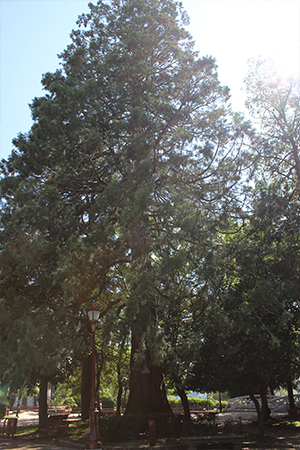 Sequoiadendron giganteum
Sequoiadendron giganteum
Giant sequoia
- Family: Taxodiaceae
- Origen: native to the western slopes of California’s Sierra Nevada range, United States
- Interesting fact: the specimen in the park can be seen from several kilometres away
It is one of the tallest and longest living trees today (with recorded heights of up to 96 metres, with the ages of some specimens ranging between 2,000 and 3,500 years). In Europe, it can reach up to 50 metres in height.
The shape of the tree is pyramidal, with a thick trunk and fibrous bark. The branches grow from the trunk and are descending.
The leaves are small needles (3-15 millimetres), awl-shaped and sharp, welded to the branch at the base. They are arranged in spirals and bent toward the tips of the branches.
Both male and female flowers grow on each tree. The males emerge in early autumn in axil and terminal catkins that release pollen in late winter. The females appear in small erect ovoid cones1.3-8 centimetres long and take 2 years to ripen.
The ripe cones are pendular and may remain on the tree for up to 20 years. Sexual maturity is not reached until the age of 80.
Source: Rosalía de Castro Park Botanical Guide


